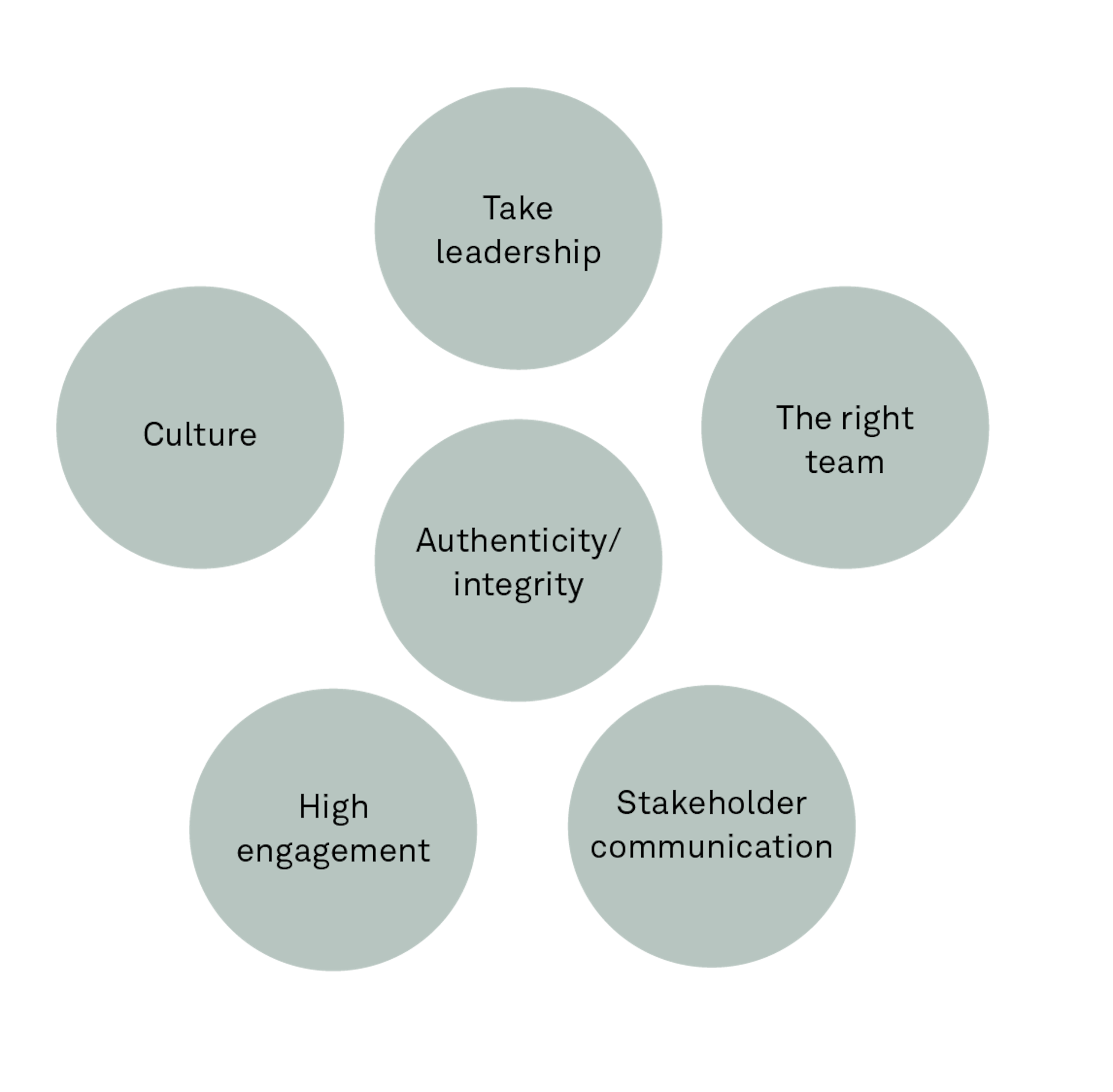What leaders really do to lead change
13 November 2015
Is the role of the change leader becoming less relevant, when more people become involved at an earlier stage? We do not think so. In fact, we believe that the role of good leadership is probably more important than ever. Leaders who give direction, and who incarnate the desired change with authenticity and integrity.
We asked 25 CEOs and top executives (from here on referred to simply as CEOs) in private companies and public organisations to share their point of view on the subject of change.
The conversations were conducted in the spring of 2014, and we asked the CEOs to reflect on leading change. From the conversations, we detected six domains of change leadership that were considered critical by the CEOs:
Authenticity and integrity
To attract followers, a leader has to be many things to many people. The trick is to pull that off while remaining true to yourself.
Although only a few of the CEOs used the word “authenticity” nearly all of them stressed the importance, but also the difficulty of staying true to yourself – your beliefs and values during periods of difficult changes.
Most of them admitted that sometimes you need to make changes which you are not 100% convinced about yourself, but that you still need to be able to look yourself in the mirror by the end of the day.
- Be clear and open about your own values
- Know what you are not willing to compromise on
- “Walk the talk” – never ask others to do things that you are not prepared to do yourself
- Be honest and open (without being naive) about your own shortcomings – do not pretend to know everything
- Make “trust” a key topic in your leadership team.
Leaders who take the lead
Change starts with you – incarnate the change you want to see. We picked up on the following wisdom from the CEOs:
- Change requires a different type of leadership than during periods of relative status quo
- Change requires you to make bold decisions – often without all the necessary information
- Put your main efforts into execution and follow through/course correction, not into developing strategies.
Forming the right team
Without the right people, nothing happens. A recurring theme was the importance of having the right people in the team to drive the change initiative.
- The top management team driving the change must be “the right people”, i.e. sharing the same view on the desired state and agree on the necessity of reaching that state (and often the first step of the change process is to gather the right group of people).
- In addition to sharing the same view on the desired state, it is also important to build a team of people with different competences and experiences.
- If the team does not consist of the right people, it may be necessary to replace the ones who do not contribute to the success of the change initiative. If resistance to the desired change exists in the core team, success will be hard to achieve.
- Sometimes, it is necessary to bring in new people from the outside in order to achieve a “critical mass” of people with the right mindsets or competences.
Effective stakeholder communication
In other words - forming a guiding coalition. A relevant mapping of important stakeholders and a profound understanding of their views on the desired state is another important success factor when driving change:
- After securing the right core team, the next step is to secure an extended team of stakeholders who actively support the change process.
- An important part of change planning is to identify and analyse important stakeholders (individuals and groups) and their standpoints in relation to the desired change.
- The middle managers are often pointed out as being an important group of stakeholders, and several CEOs also commented that “sponsors” are important stakeholders. You need to have strong backup from your sponsors before you approach the rest of the organisation with difficult messages (key sponsors should of course include the Board/owners).
Creating high engagement
Involvement and participation – the king’s road to win the hearts and minds of people. Almost all of the CEOs stressed that implementation of change stands and falls with all the people in the organisation who are prepared to think and act in a new way. Real change only occurs when people change their behaviour.
As mentioned before, the CEOs talked about transparent communication as a way to gain respect and create confidence (although it is probably not a good idea to communicate about a reorganisation or downsizing long before it actually happens. We also got some very concrete examples of methods and tools used to create high engagement:
- “Dialogue maps” and “value games” are tools that middle managers use to organise dialogues with their employees on the desired change, the road to get there and the attitudes and values needed.
- “Round tables” is a recurring open meeting that anyone in the organisation can join to discuss the ongoing change process with members from the top management.
- “Hot spots” is a quarterly meeting with 10 – 15 invited employees, the CEO and a moderator, where all questions are allowed, and with the underlying assumption that the employees will communicate to others what they have heard.
- Gathering and communicating “success stories” that exemplify behaviour moving in the right direction.
The importance of culture
All of the CEOs stressed that the culture plays a key role when it comes to succeeding with change – with the right culture in place, the chances of success are high – with the wrong culture, most change initiatives fail to deliver the expected results. Two challenges were often mentioned:
- How to clearly define and communicate “the right” culture, and what “good” looks like in terms of attitude and behaviour in the organisation?
- How to change a dysfunctional culture, or how to upgrade a fundamentally positive culture to make it support the new reality of the company?
Many interesting discussions followed and this is clearly an engaging area, but what all the CEOs agreed on was a basic fact: There are many ways to address the culturerelated challenges, there are very few “truths”, and the real mistake, which is unfortunately frequently made, is to not address this somewhat intangible area at all.








